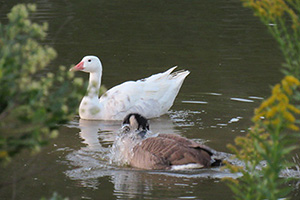Where Do We Go From Here? Time to Settle Down? Toulouse, the White Goose, Has a New Friend.
Where Do We Go From Here? Time to Settle Down? Toulouse, the White Goose, Has a New Friend.

(Photo courtesy of Bill Willis)
Story Highlights
- Birds of a different feather may and do flock together, but will they breed? Toulouse, the white goose, has never paired
- After two years observing the Canada Geese, insights into their behavior and mating have been revealed
- Only a few of the hatchlings, Mallard Ducks or Canada Geese, have reached adulthood
After years of observation, here’s what’s happened in NIEHS’s Canada Goose population. Most of the year a white goose named Toulouse would associate with other geese on campus but never paired with a female. During the breeding season he remained single until goslings hatched, then he’d befriend the new family. Some years he could get close to the goslings and helped protect them. Could 2018 be the year that Toulouse finds that special companion?

(Photo courtesy of Bill Willis)
NIEHS Campus Goose Population
The NIEHS and EPA campuses have served as nesting locations for local Canada Geese. Bird numbers fluctuate depending on the season, but usually between 60 and 75 birds can be found on the grounds.
Young adults mature by three years of age and the first clutch may not be fertile. Goose commitment is for life and should one partner die, the other may pine and not pair again for several years. The male who lost his female at the MRI window planter bed has returned to that location for the last two years in search of his mate.
Goose Breeding Results in 2016 and 2017

(Photo courtesy of Bill Willis)
Observations from the last two years have provided important information on the number of geese that paired, built nests, laid eggs, and produced goslings that survived to adulthood. Years 2016 and 2017 were very similar. In 2017, about 30 pairs were observed moving around campus and sparring for space, but not all pairs nested here. Twelve nests were built adjacent to the lake, 4 in shrub planters, 1 in a lake barrel, 1 in the Duke Power substation, and 1 in an undetermined location. Of these 19 nests, 12 were confirmed to have eggs totaling 57, of which 17 hatched. The failure of eggs to hatch ranged from possible infertility, egg predation (mammal and crow), nest flooding, eggs rolling into the lake, and female abandonment.
With clutches hatching at slightly different times, the gosling’s size helped track clutches. As could be expected, life was fraught with dangers from large fish, turtles, birds of prey, foxes, coyotes, and vehicles.
By August 2017, only 2 goslings remained, as was the case in 2016. These goslings were from the nest on the NIEHS Cafeteria Patio. Even now, there are about 75 geese remaining on campus. We will continue to have a resident population that calls the Research Triangle Park home.
The Canada geese are now forming pairs and it won’t be long before full-fledged courting behavior and nesting are observed.



